Sir John Monash, Personal Files Book 12, 1 March - 29 April 1916, Part 2
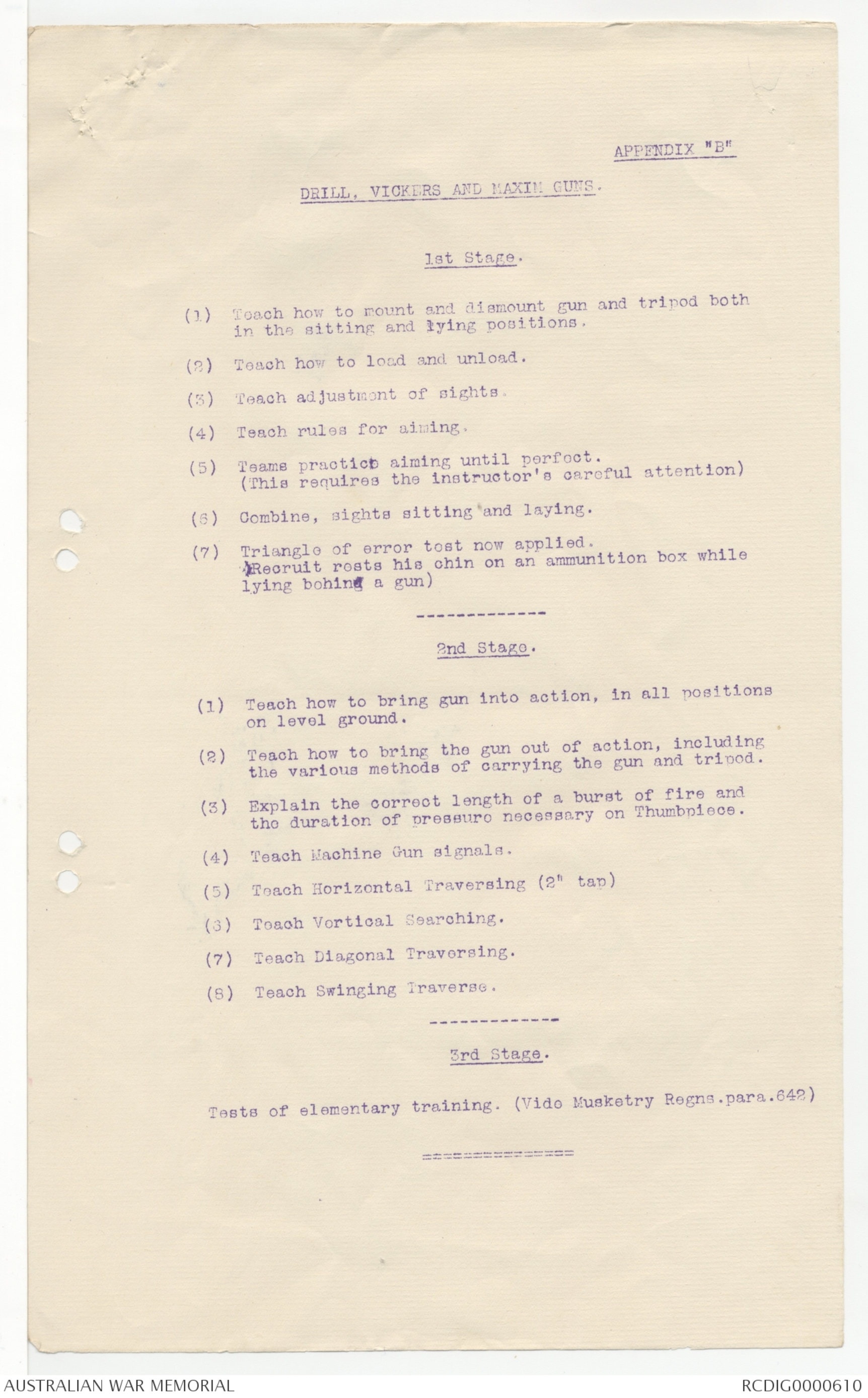
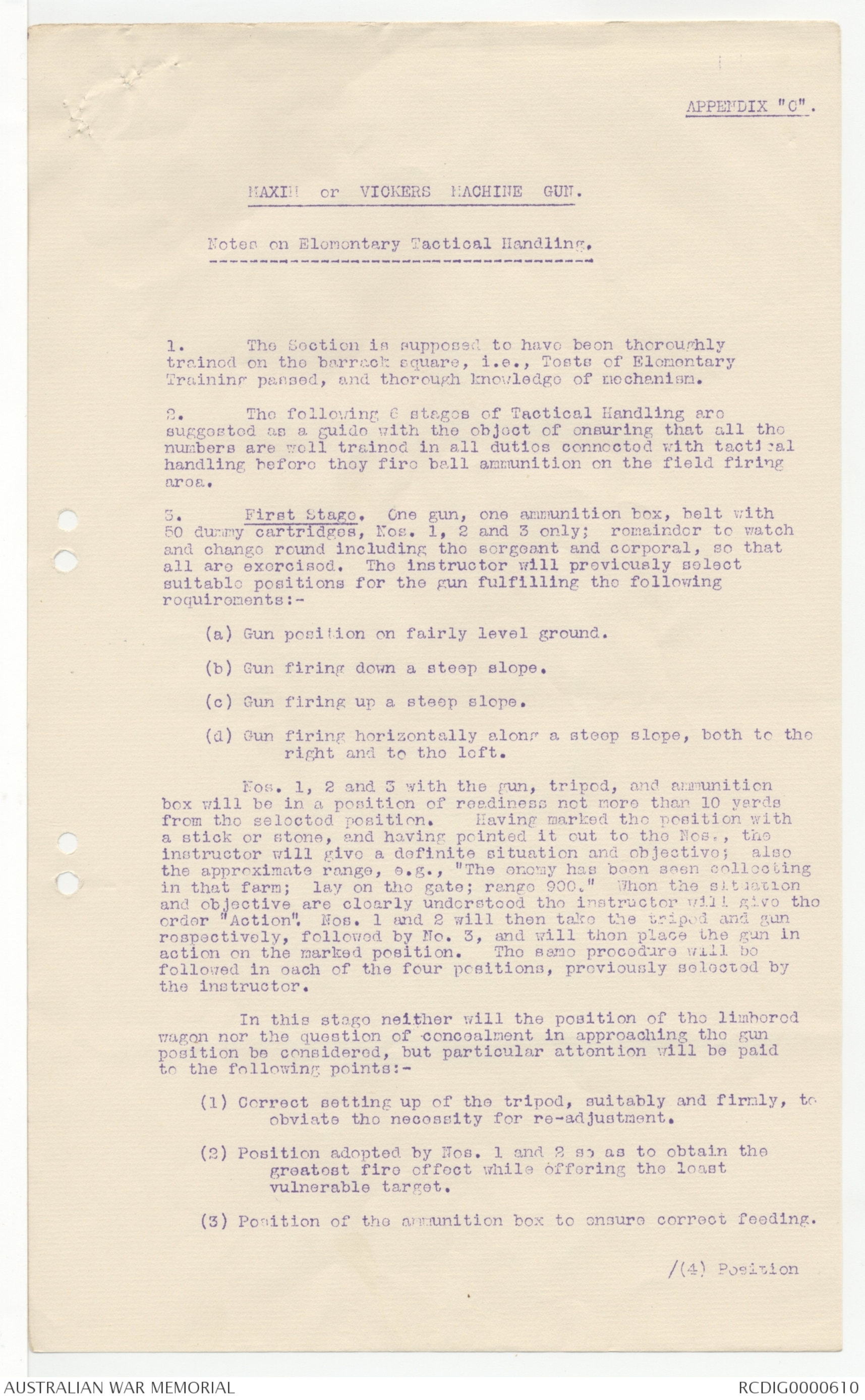
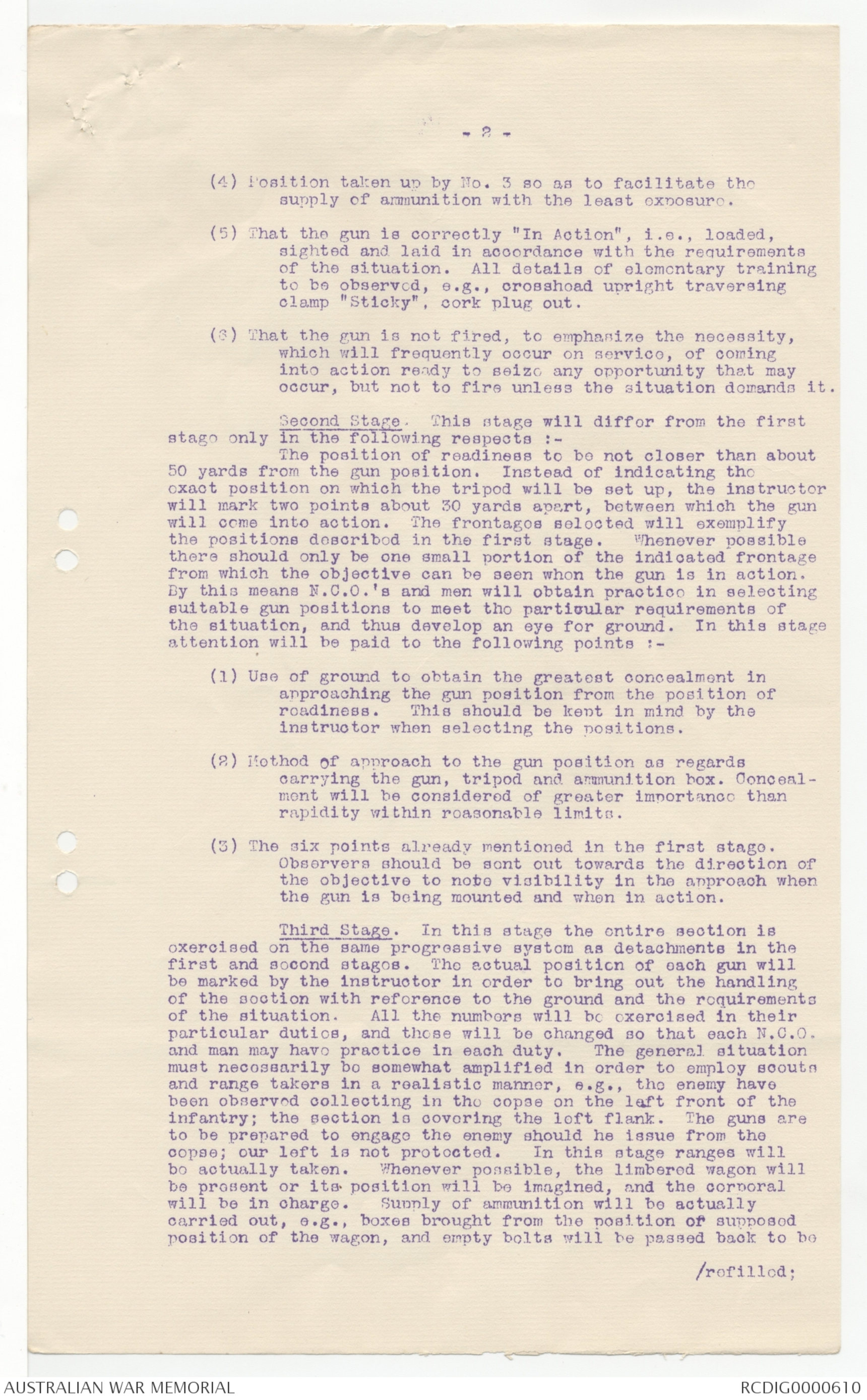
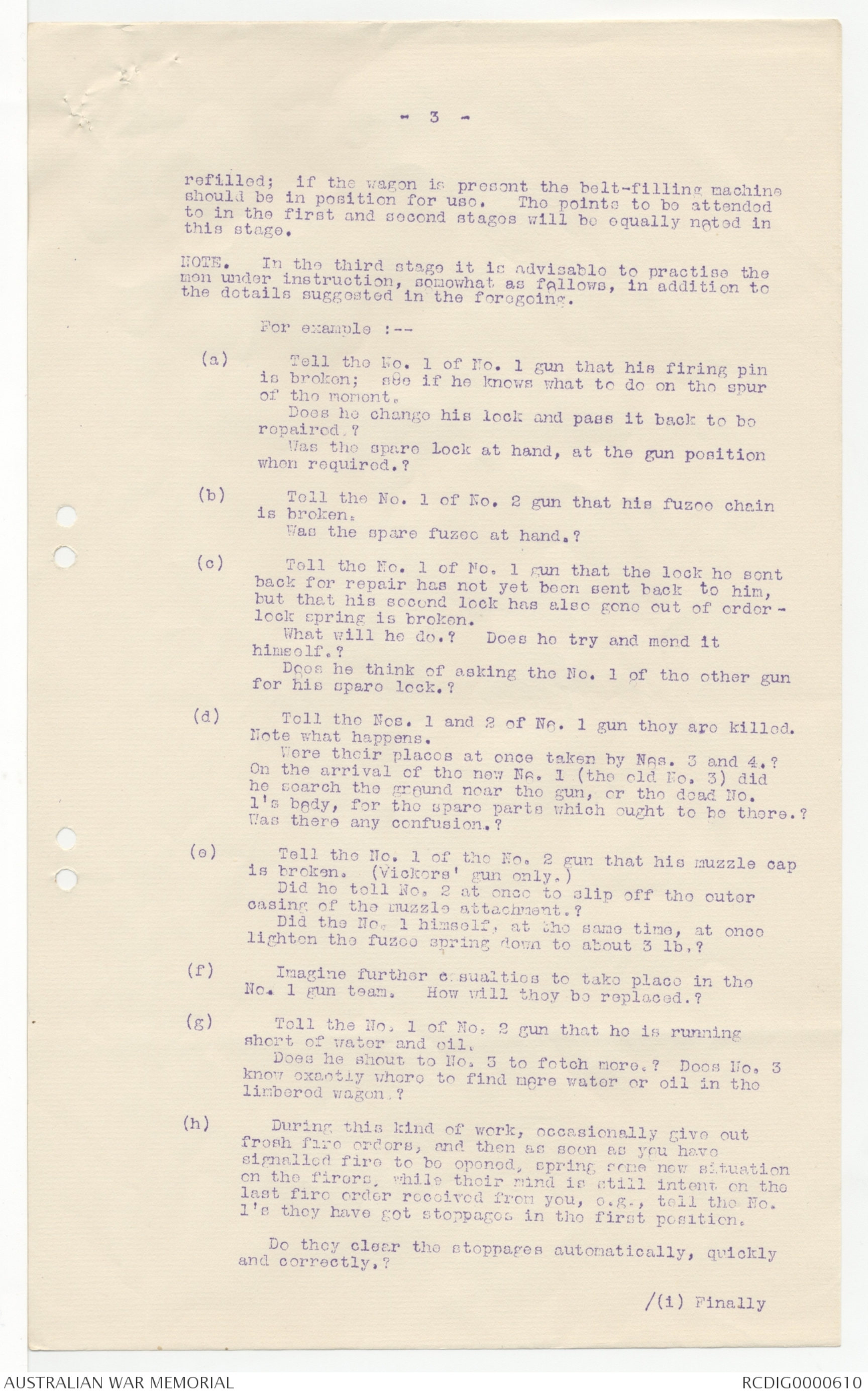
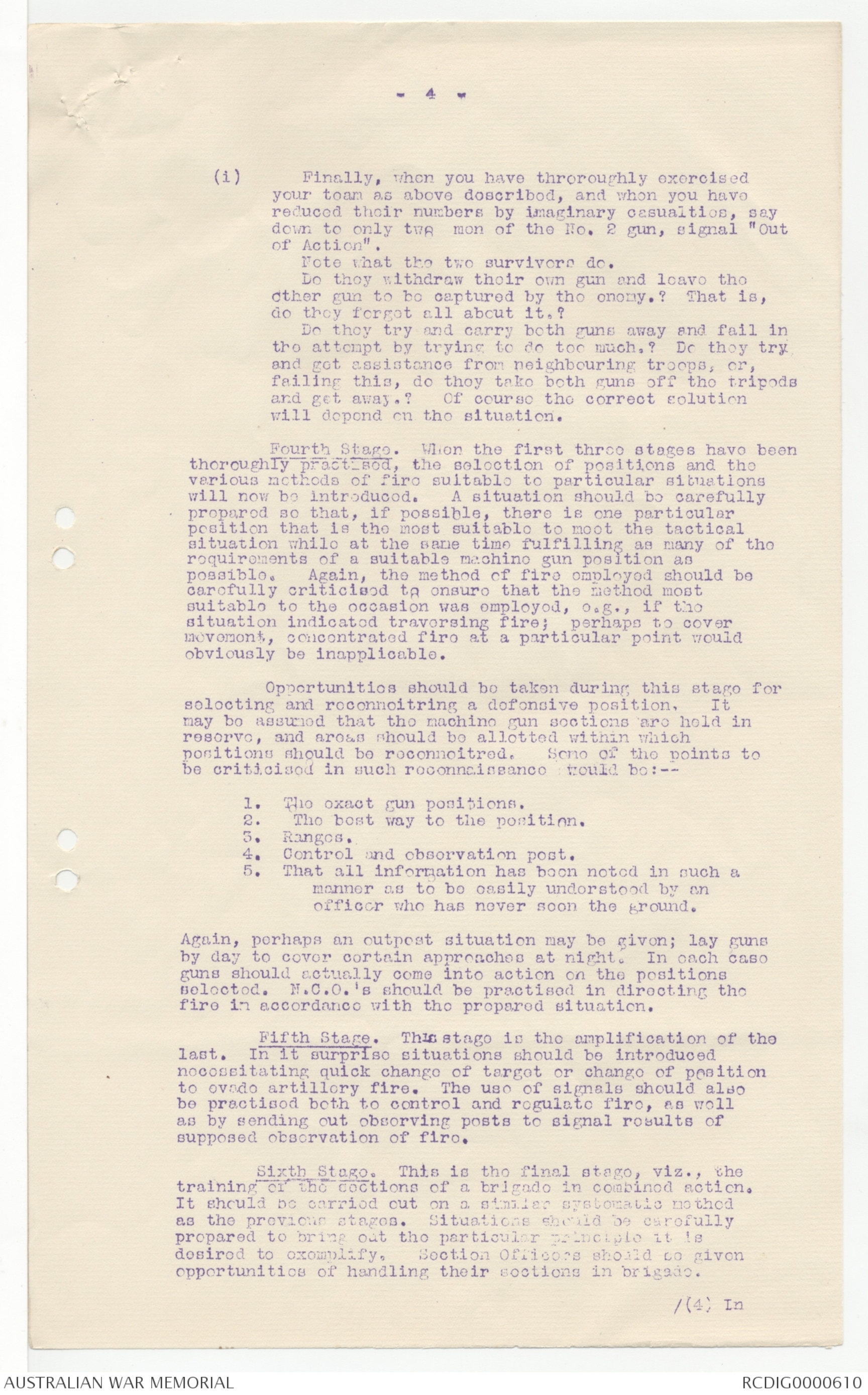
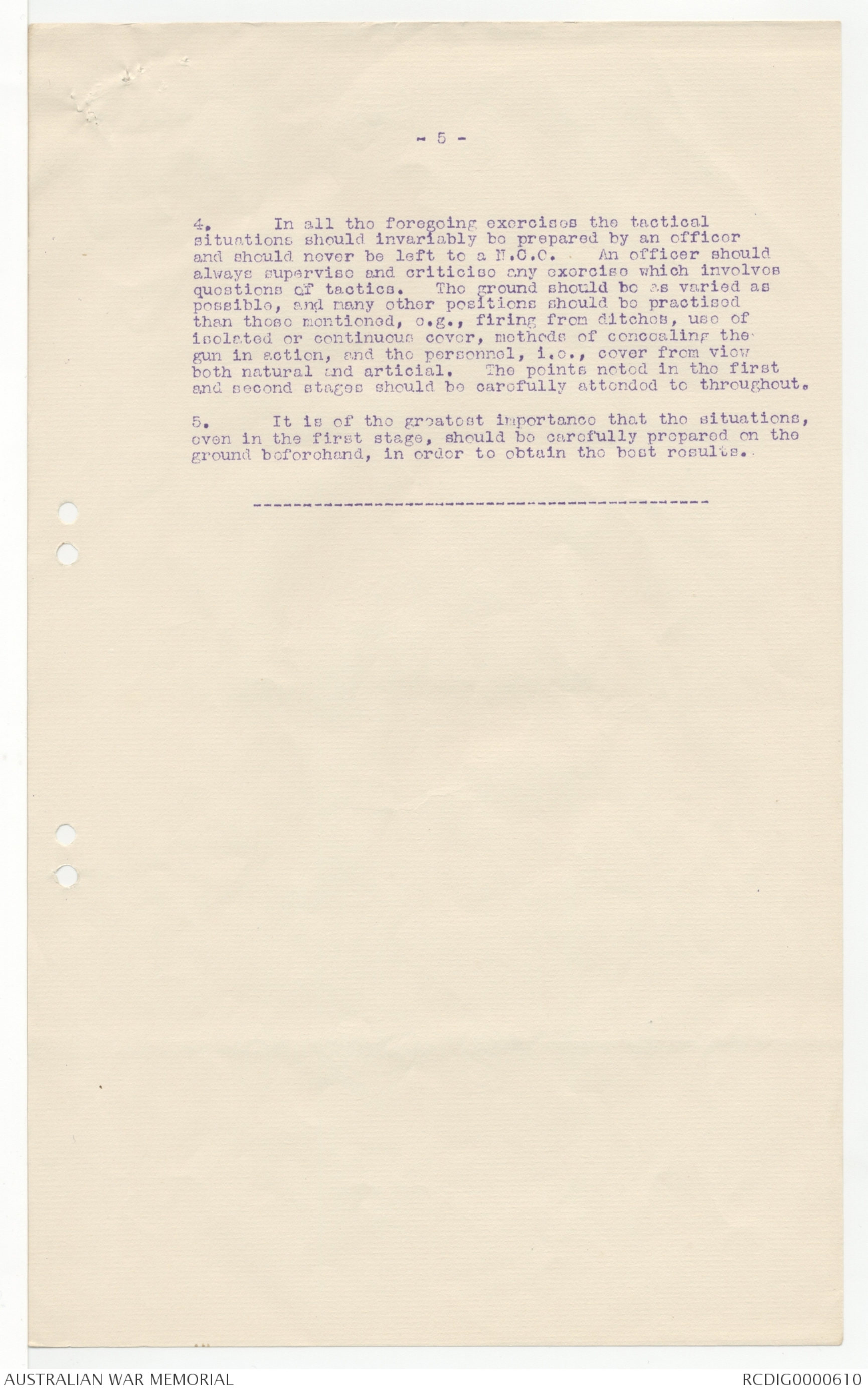
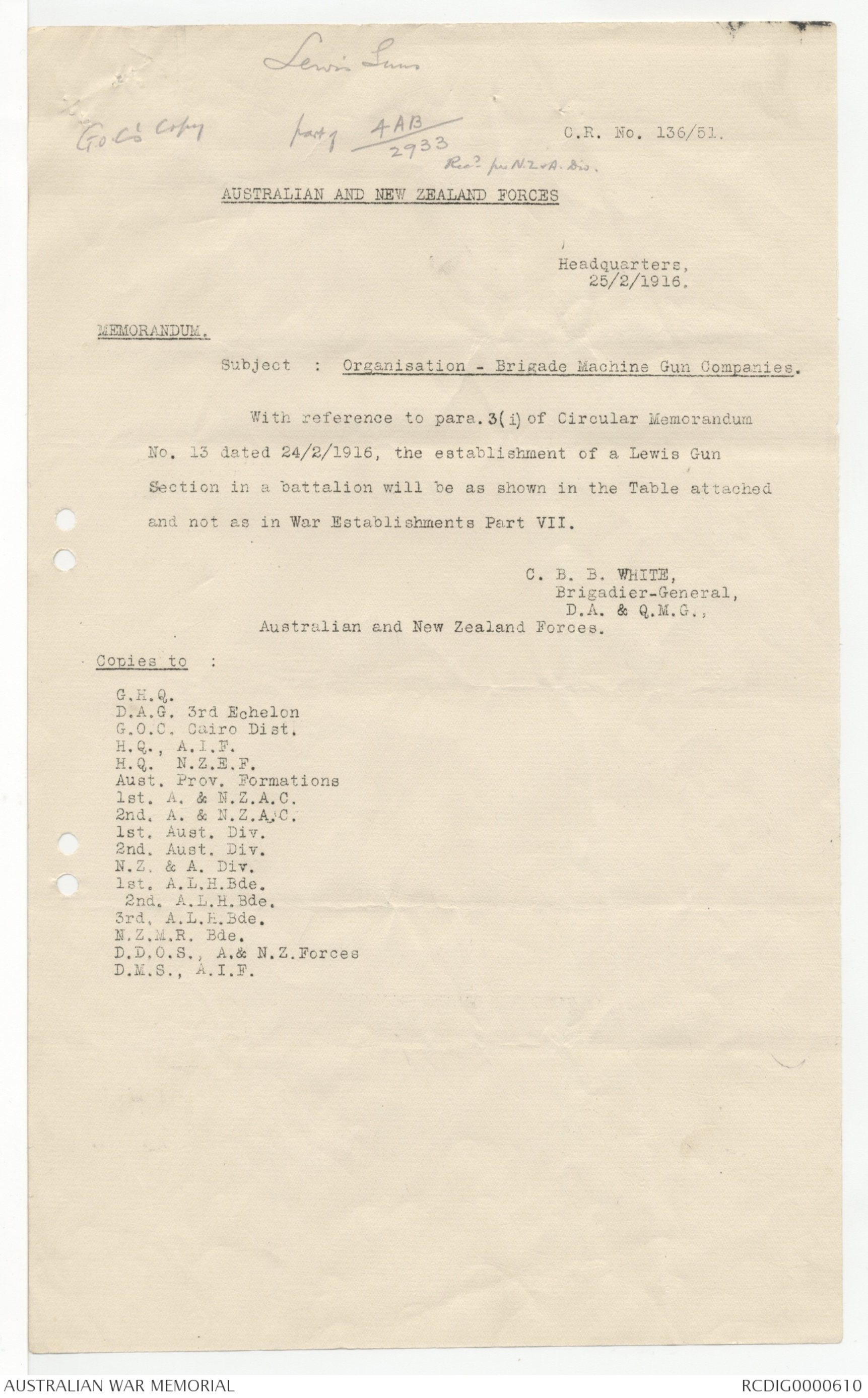
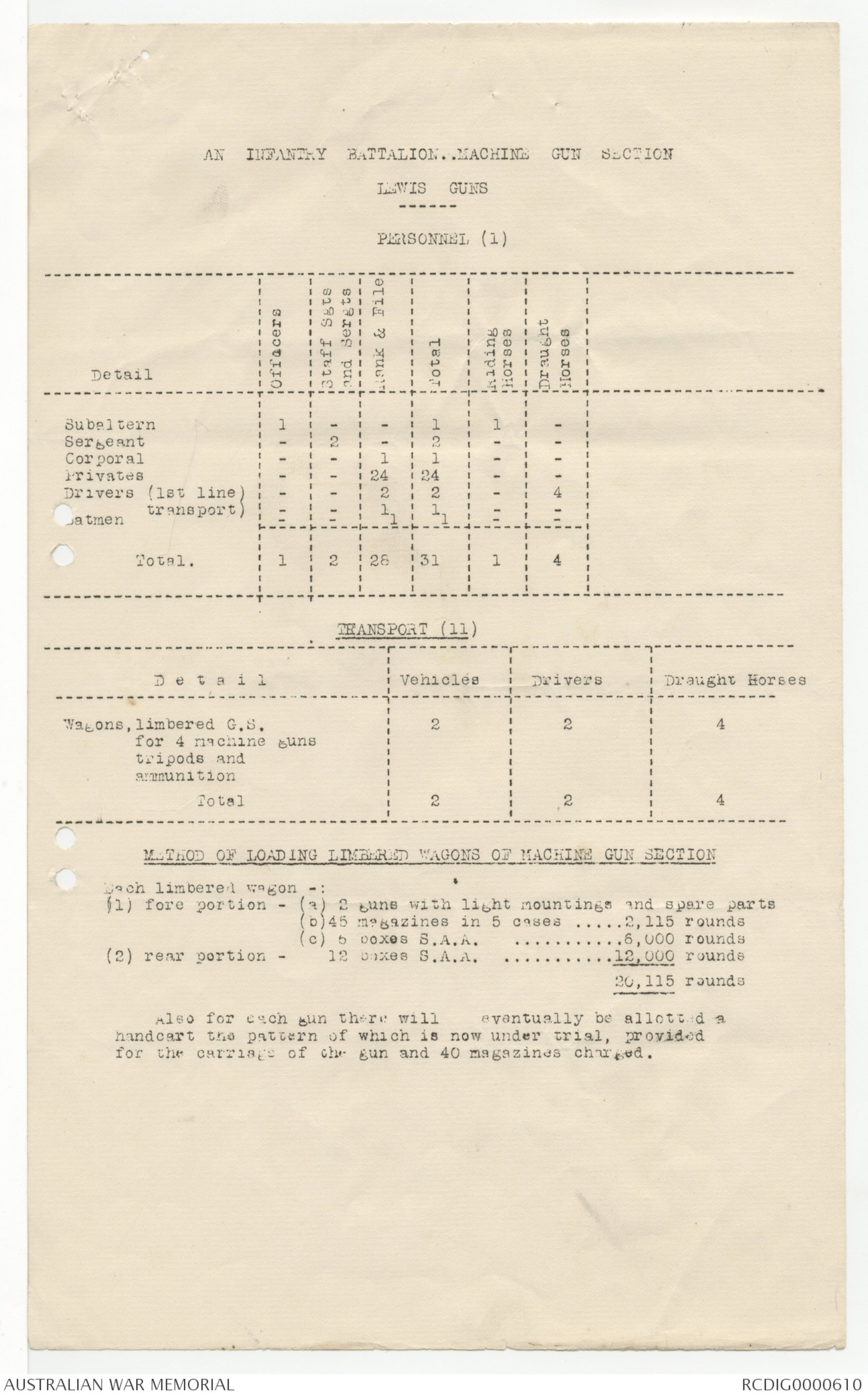
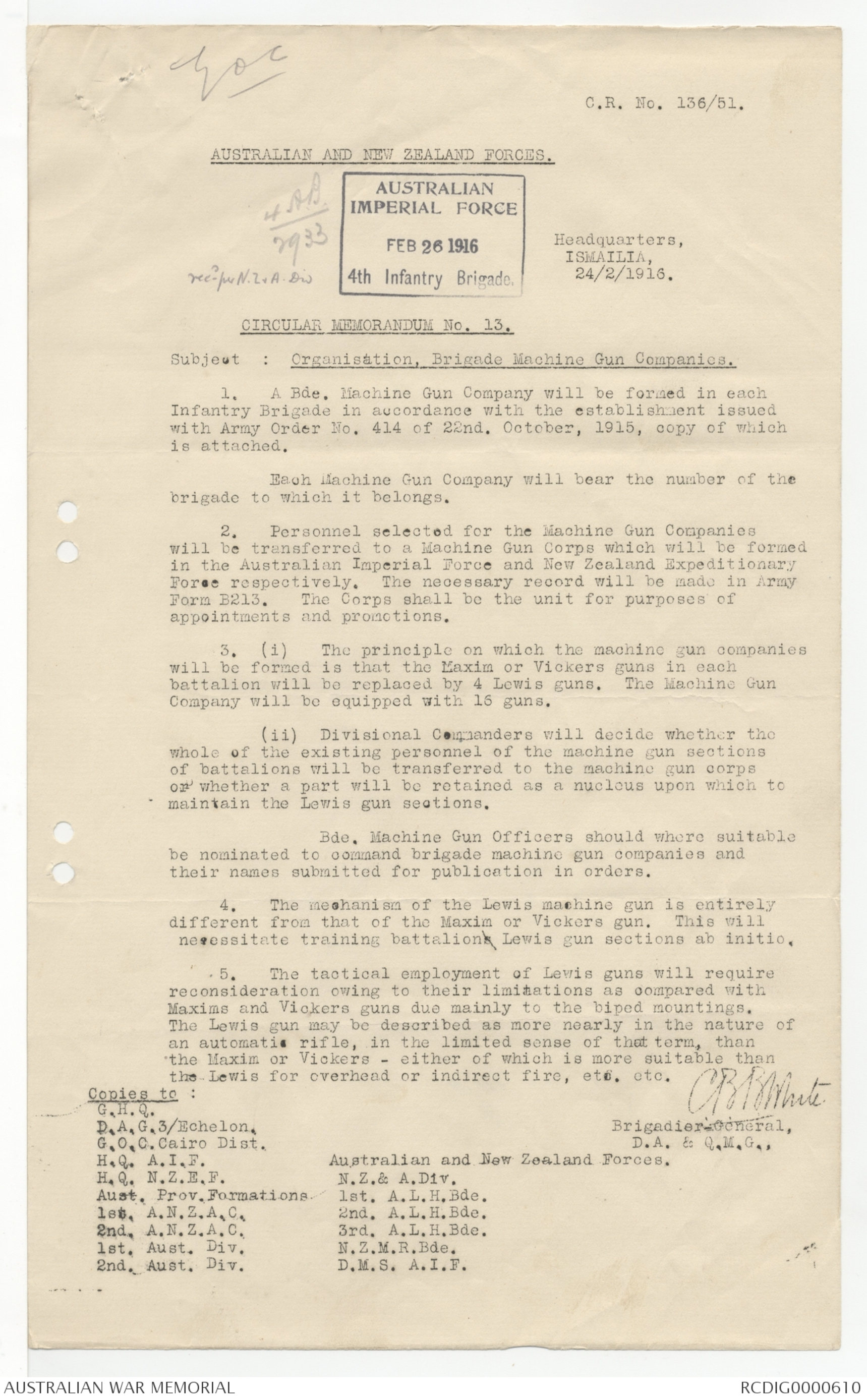
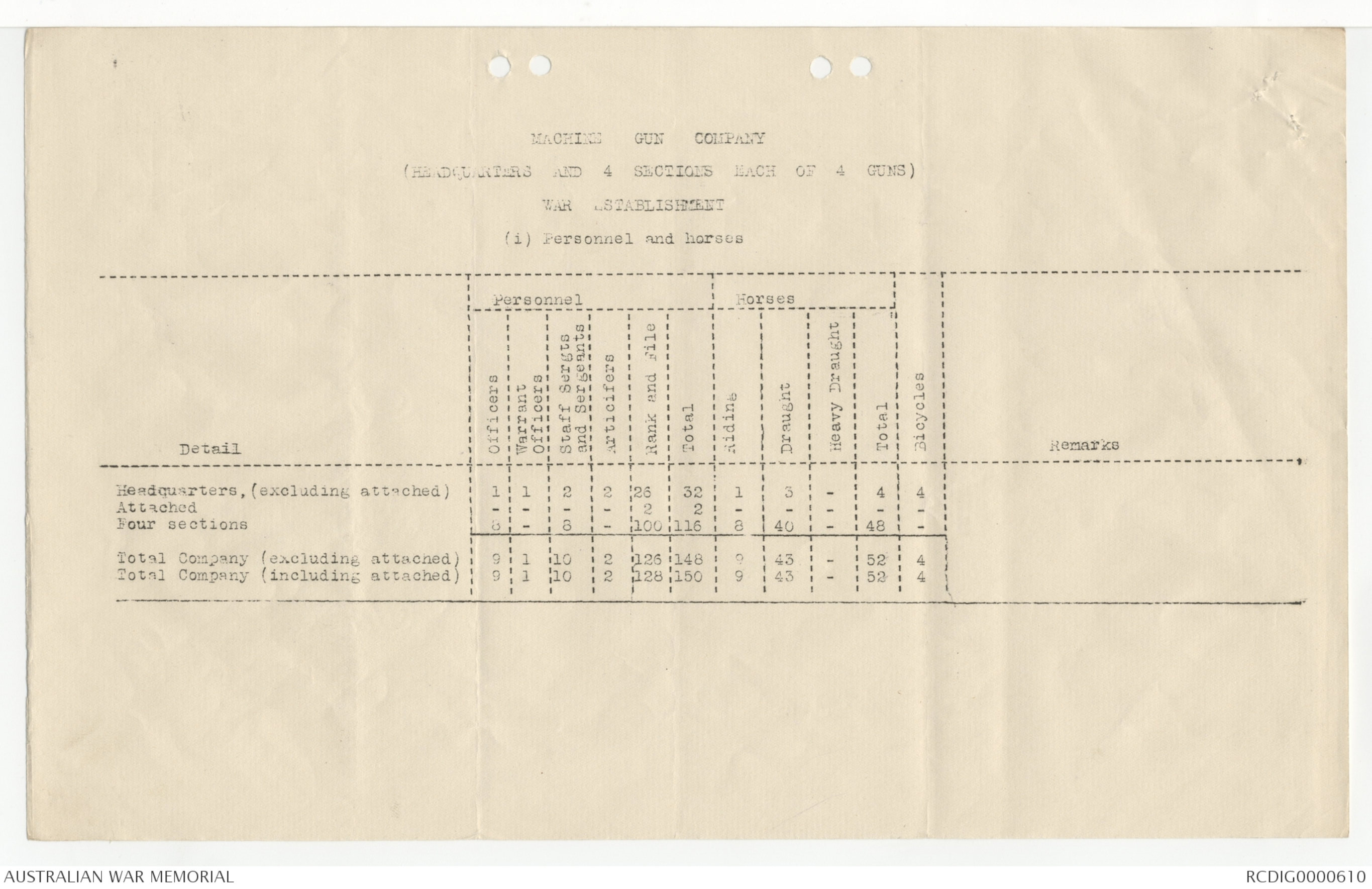
APPENDIX "B"
DRILL. VICKERS AND MAXIM GUNS.
1st Stage.
(1) Teach how to mount and dismount gun and tripod both
in the sitting and lying positions.
(2) Teach how to load and unload.
(3) Teach adjustment of sights.
(4) Teach rules for aiming.
(5) Teams practice aiming until perfect.
(This requires the instructor's careful attention.)
(6) Combine, sights sitting and laying.
(7) Triangle of error test now applied.
)Recruit rests his chin on an ammunition box while
lying behind a gun)
-------------------------------
2nd Stage.
(1) Teach how to bring gun into action, in all positions
on level ground.
(2) Teach how to bring the gun out of action, including
the various methods of carrying the gun and tripod.
(3) Explain the correct length of a burst of fire and
the duration of pressure necessary on Thumbpiece.
(4) Teach Machine Gun signals.
(5) Teach Horizontal Traversing (2" tap)
(6) Teach Vertical Searching.
(7) Teach Diagonal Traversing.
(8) Teach Swinging Traverse.
-------------------------------
3rd Stage.
Tests of elementary training. (Vide Musketry Regns.para.642)
=====================
APPENDIX "C"
MAXIM or VICKERS MACHINE GUN.
Notes on Elementary Tactical Handling.
--------------------------------------------------
1. The Section is supposed to have been thoroughly
trained on the barrack square, i.e. , Tests of Elementary
Training passed, and thorough knowledge of mechanism.
2. The following 6 stages of Tactical Handling are
suggested as a guide with the object of ensuring that all the
numbers are well trained in all duties connected with tactical
handling before they fire ball ammunition on the field firing
area.
3. First Stage. One gun, one ammunition box, belt with
50 dummy cartridges, Nos. 1, 2 and 3 only; remainder to watch
and change round including the sergeant and corporal, so that
all are exercised. The instructor will previously select
suitable positions for the gun fulfilling the following
requirements:-
(a) Gun position on fairly level ground.
(b) Gun firing down a steep slope.
(c) Gun firing up a steep slope.
(d) Gun firing horizontally along a steep slope, both to the
right and to the left.
Nos. 1, 2 and 3 with the gun, tripod, and ammunition
box will be in a position of readiness not more than 10 yards
from the selected position. Having marked the position with
a stick or stone, and having pointed it out to the Nos., the
instructor will give a definite situation and objective; also
the approximate range, e.g., "The enemy has been seen collecting
in that farm; lay on the gate; range 900." When the situation
and objective are clearly understood the instructor will give the
order "Action". Nos. 1 and 2 will then take the tripod and gun
respectively, followed by No. 3, and will then place the gun in
action on the marked position. The same procedure will be
followed in each of the four positions, previously selected by
the instructor.
In this stage neither will the position of the limbered
wagon nor the question of concealment in approaching the gun
position be considered, but particular attention will be paid
to the following points:-
(1) Correct setting up of the tripod, suitably and firmly, to
obviate the necessity for re-adjustment.
(2) Position adopted by Nos. 1 and 2 so as to obtain the
greatest fire effect while offering the least
vulnerable target.
(3) Position of the ammunition box to ensure correct feeding.
/(4) Position
- 2 -
(4) Position taken up by No. 3 so as to facilitate the
supply of ammunition with the least exposure.
(5) That the gun is correctly "In Action", i.e., loaded,
sighted and laid in accordance with the requirements
of the situation. All details of elementary training
to be observed, e.g., crosshoad upright traversing
clamp "Sticky", cork plug out.
(6) That the gun is not fired, to emphasize the necessity,
which will frequently occur on service, of coming
into action ready to seize any opportunity that may
occur, but not to fire unless the situation demands it.
Second Stage. This stage will differ from the first
stage only in the following respects :-
The position of readiness to be not closer than about
50 yards from the gun position. Instead of indicating the
exact position on which the tripod will be set up, the instructor
will mark two points about 30 yards apart, between which the gun
will come into action. The frontages selected will exemplify
the positions described in the first stage. Whenever possible
there should only be one small portion of the indicated frontage
from which the objective can be seen when the gun is in action.
By this means N.C.O.'s and men will obtain practice in selecting
suitable gun positions to meet the particular requirements of
the situation, and thus develop an eye for ground. In this stage
attention will be paid to the following points :-
(1) Use of ground to obtain the greatest concealment in
approaching the gun position from the position of
readiness. This should be kept in mind by the
instructor when selecting the positions.
(2) Method of approach to the gun position as regards
carrying the gun, tripod and ammunition box. Concealment
will be considered of greater importance than
rapidity within reasonable limits.
(3) The six points already mentioned in the first stage.
Observers should be sent out towards the direction
of the objective to note visibility in the approach
when the gun is being mounted and when in action.
Third Stage. In this stage the entire section is
exercised on the same progressive system as detachments in the
first and second stages. The actual position of each gun will
be marked by the instructor in order to bring out the handling
of the section with reference to the ground and the requirements
of the situation. All the numbers will be exercised in their
particular duties, and those will be changed so that each N.C.O.
and man may have practice in each duty. The general situation
must necessarily be somewhat amplified in order to employ scouts
and range takers in a realistic manner, e.g., the enemy have
been observed collecting in the copse on the left front of the
infantry; the section is covering the left flank. The guns are
to be prepared to engage the enemy should he issue from the
copse; our left is not protected. In this stage ranges will
be actually taken. Whenever possible, the limbered wagon will
be present or its position will be imagined, and the corporal
will be in charge. Supply of ammunition will be actually
carried out, e.g., boxes brought from the position or supposed
position of the wagon, and empty bolts will be passed back to be
/refilled;
-3-
refilled; if the wagon is present the belt-filling machine
should be in position for use. The points to be attended
to in the first and second stages will be equally noted in
this stage.
NOTE. In the third stage it is advisable to practise the
men under instruction, somewhat as follows, in addition to
the details suggested in the foregoing.
For example :--
(a) Tell the No. 1 of No. 1 gun that his firing pin
is broken; see if he knows what to do on the spur
of the moment.
Does he change his lock and pass it back to be
repaired.?
Was the spare lock at hand, at the gun position
when required.?
(b) Tell the No. 1 of No. 2 gun that his fuzee chain
is broken.
Was the spare fuzee at hand.?
(c) Tell the No. 1 of No. 1 gun that the lock he sent
back for repair has not yet been sent back to him,
but that his second lock has also gone out of order -
lock spring is broken.
What will he do.? Does he try and mend it
himself.?
Does he think of asking the No. 1 of the other gun
for his spare lock.?
(d) Tell the Nos. 1 and 2 of No. 1 gun they are killed.
Note what happens.
Were their places at once taken by Nos. 3 and 4.?
On arrival of the new No. 1 (the old No. 3) did
he search the ground near the gun, or the dead No.
1's body, for the spare parts which ought to be there.?
Was there any confusion.?
(e) Tell the No. 1 of the No. 2 gun that his muzzle cap
is broken. (Vickers' gun only.)
Did he tell No. 2 at once to slip off the outer
casing of the muzzle attachment.?
Did the No. 1 himself, at the same time, at once
lighten the fuzee spring down to about 3 lb.?
(f) Imagine further casualties to take place in the
No. 1 gun team. How will they be replaced.?
(g) Tell the No. 1 of No. 2 gun that he is running
short of water and oil.
Does he shout to No. 3 to fetch more.? Does No. 3
know exactly where to find more water or oil in the
limbered wagon.?
(h) During this kind of work, occasionally give out
fresh fire orders, and then as soon as you have
signalled fire to be opened, spring some new situation
on the firers, while their mind is still intent on the
last fire order received from you, e.g. tell the No.
1's they have got stoppages in the first position.
Do they clear the stoppages automatically, quickly
and correctly.?
/(i) Finally
-4-
(i) Finally, when you have thoroughly exercised
your team as above described, and when you have
reduced their numbers by imaginary casualties, say
down to only two men of the No. 2 gun, signal "Out
of Action".
Note what the two survivors do.
Do they withdraw their own gun and leave the
other gun to be captured by the enemy.? That is,
do they forget all about it.?
Do they try and carry both guns away and fail in
the attempt by trying to do too much.? Do they try
and get assistance from neighbouring troops, or
failing this, do they take both guns off the tripods
and get away.? Of course the correct solution
will depend on the situation.
Fourth Stage. When the first three stages have been
thoroughly practised, the selection of positions and the
various methods of fire suitable to particular situations
will now be introduced. A situation should be carefully
prepared so that, if possible, there is one particular
position that is the most suitable to meet the tactical
situation while at the same time fulfilling as many of the
requirements of a suitable machine gun position as
possible. Again, the method of fire employed should be
carefully criticised to ensure that the method most
suitable to the occasion was employed, e.g. if the
situation indicated traversing fire; perhaps to cover
movement, concentrated fire at a particular point would
obviously be inapplicable.
Opportunities should be taken during this stage for
selecting and reconnoitring a defensive position. It
may be assumed that the machine gun sections are held in
reserve, and areas should be allotted within which
positions should be reconnoitered. Some of the points to
be criticised in such reconnaissance would be :-
1. The exact gun positions.
2. The best way to the position.
3. Ranges.
4. Control and observation post.
5. That all information has been noted in such a
manner as to be easily understood by an
officer who has never seen the ground.
Again, perhaps an outpost situation may be given; lay guns
by day to cover certain approaches at night. In each case
guns should actually come into action on the positions
selected. N.C.O.'s should be practised in directing the
fire in accordance with the prepared situation.
Fifth Stage. This stage is the amplification of the
last. In it surprise situations should be introduced
necessitating quick change of target or change of position
to evade artillery fire. The use of signals should also
be practised both to control and regulate fire, as well
as by sending out observing posts to signal results of
supposed observation of fire.
Sixth Stage. This is the final stage, viz., the
training of the sections of a brigade in combined action.
It should be carried out on a similar systematic method
as the previous stages. Situations should be carefully
prepared to bring out the particular principle it is
desired to exemplify. Section Officers should be given
opportunities of handling their sections in brigade.
/(4) In
-5-
4. In all the foregoing exercises the tactical
situations should invariably be prepared by an officer
and should never be left to a N.C.O. An officer should
always supervise and criticise any exercise which involves
questions or tactics. The ground should be varied as
possible, and many other positions should be practised
than those mentioned,. e.g., firing from ditches, use of
isolated or continuous cover, methods of concealing the
gun in section, and the personnel, i.e., cover from view
both natural and articial. The points noted in the first
and second stages should be carefully attended to throughout.
5. It is the of the greatest importance that the situations,
even in the first stage, should be carefully prepared on the
ground beforehand, in order to obtain the best results.
Lewis Guns
GOC's Copy
part of 4AB/2933
C.R. No. 136/51
Rec? for N.Z & A. Div
AUSTRALIAN AND NEW ZEALAND FORCES
Headquarters
25/2/1916
MEMORANDUM
Subject: Organisation - Brigade Machine Gun Companies.
With reference to para. 3(i) of Circular Memorandum
No. 13 dated 24/2/1916, the establishment of a Lewis Gun
Section in a battalion will be shown in the Table attached
and not as in War Establishment Part VII.
C.B.B. WHITE
Brigadier-General
D.A. & Q.M.G.,
Australian and New Zealand Forces
Copies to:
G.H.Q
D.A.G. 3rd Echelon
G.O.C Cairo Dist.
H.Q. A.I.F
H.Q. N.Z.E.F.
Aust. Prov. Formations
1st. A. & N.Z.A.C.
2nd. A. & N.Z.A.C.
1st. Aust. Div.
2nd Aust. Div.
N.Z. & A. Div.
1st. A.L.H.Bde
2nd. A.L.H.Bde
3rd. A.L.H.Bde
N.Z.M.R. Bde
D.D.O.S, A.&N.Z. Forces
D.M.S., A.I.F.
AN INFANTRY BATTALION MACHINE GUN SECTION
LEWIS GUNS
PERSONNEL (1)
| Detail | Officers | Staff Sgts and Sergts |
Rank & File | Total | Riding Horses |
Draught Horses |
| Subaltern | 1 | - | - | 1 | 1 | - |
| Sergeant | - | 2 | - | 2 | - | - |
| Corporal | - | - | 1 | 1 | - | - |
| Private | - | - | 24 | 24 | - | - |
| Drivers (lst line) | - | - | 2 | 2 | - | 4 |
| transport) | - | - | 1 | 1 | - | - |
| Batmen | - | - | 1 | 1 | - | - |
| Total. | 1 | 2 | 28 | 31 | 1 | 4 |
Transport (11)
| Detail | Vehicles | Drivers | Draught horses |
| Wagons, limbered G.S for 4 machine guns tripods and ammunition |
2 | 2 | 4 |
| Total | 2 | 2 | 4 |
METHOD OF LOADING LIMBERED WAGONS OF MACHINE GUN SECTION
| Each limbered wagon -: | ||
| (1) fore portion | (a) 2 guns with light mountings and spare parts | |
| (b) 45 magazines in 5 cases ................ | 2,115 rounds | |
| (c) 5 boxes S.A.A ........................................ | 6,000 rounds | |
| (2) rear portion - | 12 boxes SA.A. ............................................. | 12,000 rounds |
| 20,115 rounds |
Also for each gun there will eventually be allotted a
handcart the pattern of which is now under trial, provided
for the carriage of the gun and 40 magazines charged.
G.O.C
C.R. No. 136/51
AUSTRALIAN AND NEW ZEALAND FORCES.
4AB/2933
AUSTRALIAN
IMPERIAL FORCE
FEB 26 1916
4th Infantry Brigade
rec-per N.Z &A Div
Headquarters,
ISMAILIA,
24/2/1916.
CIRCULAR MEMORANDUM NO. 13.
Subject: Organisation, Brigade Machine Gun Companies.
1. A Bde. Machine Gun Company will be formed in each
Infantry Brigade in accordance with the establishment issued
with Army Order No. 414 of 22nd, October, 1915, copy of which
is attached.
Each Machine Gun Company will bear the number of the
brigade to which it belongs.
2. Personnel selected for the Machine Gun Companies
will be transferred to a Machine Gun Corps which will be formed
in the Australian Imperial Force and New Zealand Expeditionary
Force respectively. The necessary record will be made in Army
Form B213. The Corps shall be the unit for the purpose of
appointments and promotions.
3. (i) The principle on which the machine gun companies
will be formed is that the Maxim or Vickers guns in each
battalion will be replace by 4 Lewis guns. The Machine Gun
Company will be equipped with 16 guns.
(ii) Divisional Commanders will decide whether the
whole of the existing personnel of the machine gun sections
of battalions will be transferred to the machine gun corps
or whether a part will be retained as a nucleus upon which to
maintain the Lewis gun sections.
Bde. Machine Gun Officers should where suitable
be nominated to command bridge machine gun companies and
their names submitted for publication in orders.
4. The mechanism of the Lewis machine gun is entirely
different from that of the Maxim or Vickers gun. This will
necessitate training battalions Lewis gun sections ab initio.
5. The tactical employment of Lewis guns will require
reconsideration owing to their limitations as compared with
Maxims and Vickers guns due mainly to the biped mountings.
The Lewis gun may be described as more nearly in the nature of
an automatic rifle, in the limited sense of that term, than
the Maxim or Vickers - either of which is more suitable than
the Lewis for overhead or indirect fire, etc. etc.
C.B.B White
Brigadier-General
D.A. & Q.M.G.
Copies to:
G.H.Q
D.A.G. 3rd/Echelon
G.O.C.Cairo Dist.
H.Q. A.I.F Australian and New Zealand Forces.
H.Q. N.Z.E.F. N.Z.& A.Div.
Aust Prov. Formations 1st. A.L.H.Bde
1st. A.N.Z.A.C. 2nd. A.L.H.Bde
2nd. A.N.Z.A.C. 3rd. A.L.H.Bde
1st. Aust. Div. N.Z.M.R. Bde
2nd Aust. Div. D.M.S. A.I.F.
MACHINE GUN COMPANY
(HEADQUARTERS AND 4 SECTIONS EACH OF 4 GUNS)
WAR ESTABLISHMENT
(1) Personnel and horses
| Personnel | Horses | |||||||||||
| Detail | Officers | Warrant Officers |
Staff Sergts & Sergeants |
Artificers | Rank and File |
Total | Riding | Draught | Heavy Draught |
Total | Bicycles | Remarks |
| Headquarters, (excluding attached) |
1 | 1 | 2 | 2 | 26 | 32 | 1 | 3 | - | 4 | 4 | |
| Attached | - | - | - | - | 2 | - | - | - | - | - | - | |
| Four Sections | 8 | - | 8 | - | 100 | 116 | 8 | 40 | - | 48 | - | |
| Total Company (excluding attached) | 9 | 1 | 10 | 2 | 126 | 148 | 9 | 43 | - | 52 | 4 | |
| Total Company (including attached) | 9 | 1 | 10 | 2 | 128 | 150 | 9 | 43 | - | 52 | 4 | |
 Maralyn K
Maralyn KThis transcription item is now locked to you for editing. To release the lock either Save your changes or Cancel.
This lock will be automatically released after 60 minutes of inactivity.